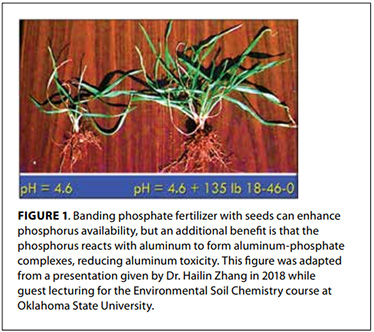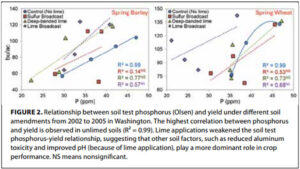The role of phosphorus in ameliorating soil acidity in Washington grain production
For Washington’s wheat and barley growers, optimizing soil fertility is key to achieving high yields and maintaining long-term soil health. A critical factor influencing yield potential in recently acidified soils in Eastern Washington is the presence of high levels of exchangeable aluminum, which impairs root development and nutrient uptake. Research conducted from 2002 to 2005 provides valuable insights into how phosphorus can mitigate aluminum stress and improve grain production across Washington’s dryland cropping systems. However, given the elapsed time, further research is needed to understand the short-term effects of phosphorus applications in reducing aluminum toxicity, which may present a more economically viable alternative to liming.
Acidic soils, becoming more common in the Inland Pacific Northwest, pose a significant challenge for wheat and barley farmers. As soil pH drops below 5.5, aluminum becomes more soluble and can reach toxic levels, restricting root growth and reducing nutrient access. This leads to stunted plants and lower yields.
 Past studies have demonstrated that phosphorus plays a crucial role in alleviating aluminum toxicity. By binding with aluminum in the soil, phosphorus reduces its toxicity and allows for better root proliferation, even at low soil pH (see Figure 1 on next page). This protective effect needs to be explored across different soil management systems in Washington, including no-till and conventional tillage systems.
Past studies have demonstrated that phosphorus plays a crucial role in alleviating aluminum toxicity. By binding with aluminum in the soil, phosphorus reduces its toxicity and allows for better root proliferation, even at low soil pH (see Figure 1 on next page). This protective effect needs to be explored across different soil management systems in Washington, including no-till and conventional tillage systems.
Given the high cost of lime application, phosphorus fertilization could offer a more cost-effective strategy for short-term aluminum toxicity mitigation.
U.S. Department of Agriculture researchers with the Agricultural Research Service in Pullman evaluated phosphorus availability and its impact on the yield of two of Washington most important grain crops — spring barley and spring wheat. This work studied the effect of different treatments (no lime control, surface broadcast lime, surface broadcast sulfur, and annual deep banding of lime). Soil pH in the top 4 inches increased after broadcast lime to around 5.5 but slightly decreased over time to around 5.4 in 2005. For control and deep band, the pH went from around 5 to 4.9. The sulfur treatment had the lowest pH, between 4.8 and 4.6. In the short-term, from 2002–05, their findings show a direct correlation between increased phosphorus availability (Olsen method) and increased crop yields, particularly when lime was not applied as a soil amendment (see Figure 2), reinforcing the importance of strategic phosphorus management in fertility programs on acidic soils. The need for updated research is particularly relevant when considering related studies conducted in Oklahoma (2014)1 and Montana (2018–2019)2, which also explored the interaction between phosphorus and aluminum in acidic soils. The Montana study showed that phosphorus availability increased yield in some conditions even when soil test phosphorus levels were already very high, while the Oklahoma study showed that phosphorus application can help protect plant roots from aluminum toxicity in acidic soils.
Practical recommendations for Washington growers include:
- Regular soil testing should be the foundation of any fertility plan. Monitoring soil pH and exchangeable aluminum levels can help identify areas requiring intervention.
- Applying phosphorus as a starter fertilizer placed with the seed can enhance root growth and crop performance, particularly in acidic soils with high levels of exchangeable aluminum.
 Figure 2 presents scatter plots that track the relationship between phosphorus levels in the soil and yield. The x-axis shows the soil test phosphorus concentration in the soil, while the y-axis represents how well the crops yielded. Different symbols and colors represent different soil treatments:
Figure 2 presents scatter plots that track the relationship between phosphorus levels in the soil and yield. The x-axis shows the soil test phosphorus concentration in the soil, while the y-axis represents how well the crops yielded. Different symbols and colors represent different soil treatments:
- Control (no lime) — Blue circles (blue regression line).
- Sulfur broadcast to lower soil pH (one time, 892 pounds per acre) — Red squares (red dashed regression line).
- Deep-banded lime (200 pounds per acre annually) — Green triangles (green-dashed regression line).
- Broadcast lime (one time, 6,245 pounds per acre) — Purple diamonds (purple-dashed regression line).
Each treatment has its own trend line, and the R² value next to the treatment tells us how well phosphorus levels explain yield differences. A higher R² means soil test phosphorus has a strong influence on yield, while a lower R² means other factors might be at play.
What can we learn from Figure 2?
- Phosphorus is most important in unlimed soils. The control (no lime) treatment shows the strongest relationship between phosphorus and grain yield. This means that in acidic soils without lime, adding phosphorus can make a big difference in how much grain is produced.
- Adding lime weakens the link between phosphorus and yield. In plots where lime was applied (either deep-banded or broadcast), the connection between soil test phosphorus and yield is not significant. This suggests that once lime is added, other factors like improved soil pH and reduced aluminum toxicity because of lime play a bigger role than phosphorus in helping crops grow.
- The big picture. If soil is acidic and unlimed, adding phosphorus can dramatically boost yield in the short-term. After liming, other factors become more important, so extra phosphorus may not have the same effect.
For farmers, this means that if your soil is acidic and you’re not using lime, phosphorus fertilizer may significantly improve crop yield because it will decrease aluminum toxicity even at lower soil pH.
If you have already applied lime, phosphorus may not be as critical and focusing on overall soil nutrient balance may be more beneficial.
Future research should explore how lime and phosphorus interact to refine soil management strategies. By understanding these interactions, farmers can make smarter, more cost-effective decisions about phosphorus fertilizer and lime applications to maximize grain production.
Cited work
Arnall, B. 2014. “Phosphorus fertilizer protects roots from aluminum toxicity in acid Oklahoma soils.” Oklahoma State University Extension. Available at https://extension.okstate.edu/programs/precision-ag-and-soil-fertility/site-files/information/docs/phosphorus-fertilizer-protects-roots-from-aluminum-toxicity.pdf
(verified 7 April 2025).
Engel, R., C. Jones, and S. Fordyce. 2020. “Soil acidification: Mitigating yield loss with seed-placed phosphorus and Aglime.” Fertilizer Fact 79 – MSU Extension Fertilizer Facts | Montana State University. Available at https://landresources.montana.edu/fertilizerfacts/html/FF79.html (verified 7 April 2025).
This article originally appeared in the June 2025 issue of Wheat Life Magazine.

Joao Antonangelo
Assistant Professor, Washington State University's Department of Crop and Soil Sciences

Rich Koenig
Professor and Soil Specialist, Washington State University's Department of Crop and Soil Sciences
Joaquin Casanova
Research Agricultural Engineer, U.S. Department of Agriculture-Agricultural Research Service
David Huggins
Research Leader, Northwest Sustainable Agroecosystems Research Unit
